Rail Engineer has often written about the problems of low adhesion caused by, inter alia, leaf debris rolled into the railhead. As a reminder, dry leaf debris can cause wrong-side track circuit failures and, when wet, can lead to very low wheel-rail friction levels.
A coefficient of friction of approximately 0.2 will allow trains to brake normally, but wet leaf debris firmly rolled into the rail can deliver an exceptionally low coefficient of friction in the order of 0.01. To put this in context, the coefficient of friction in a well-lubricated car engine is circa 0.05.
Every Autumn, Network Rail runs Rail Head Treatment Trains (RHTT) to clean leaf debris from the rails. These trains blast the leaf debris, which by now has been firmly rolled onto the rail head by passing trains, with water jets at between 1,000 and 1,500 bar and then deposit sandite – sand with some ground metallic material suspended in a sticky paste. These trains carry a very large quantity of water and sandite, are very effective, but also use capacity on the network.
Are there better techniques for cleaning the rails? Could they be deployed on service trains to avoid the loss of capacity? This is something that the Adhesion Research Group (a sub-group of RSSB’s Vehicle Track System Interface Committee) has been researching for some time. Four alternative methods were presented in a recent webinar hosted by RSSB, and the number of questions asked after the presentations was testament to the interest in the topic.
Four techniques were presented: dry ice, plasma, laser and, lastly, a very surprising solution, given that conventional wisdom says water and leaves are part of the problem, not the solution – improved braking through controlled water addition.
Dry ice
Professor Roger Lewis from Sheffield University described the use of dry ice (solid carbon dioxide CO2) pellets to clean the rail. The principle is similar to the sand or soda blasting used to clean corroded steel; compressed air and the kinetic energy of the pellets bombard the contamination, although in this case, the thermal shock of the cold pellets makes the leaf film more brittle and the sudden expansion of the CO2 gas aids the removal of the leaf film.

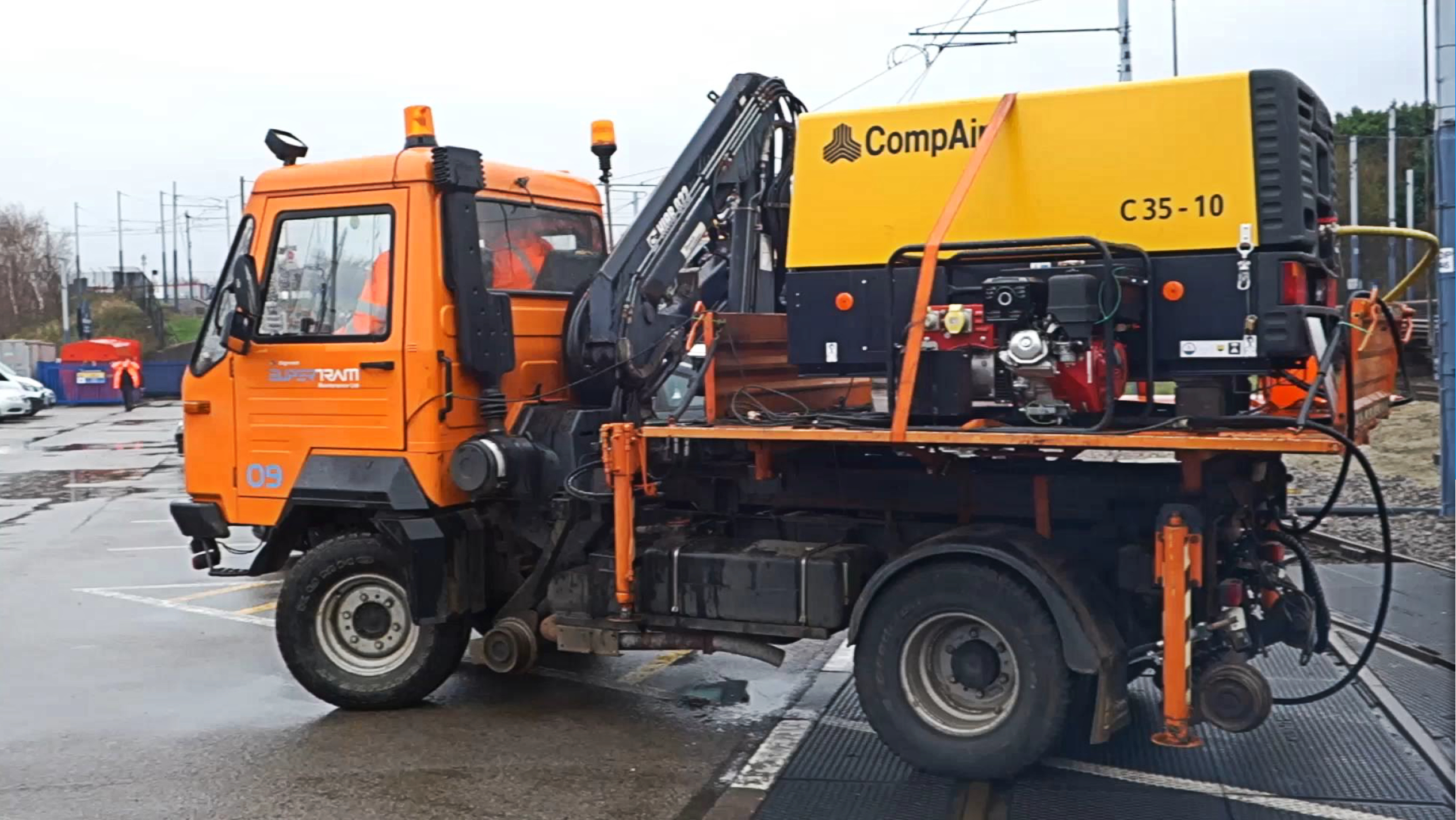
It is useful to recall that CO2 does not exist as a liquid at atmospheric pressure, transitioning from solid to gas or vice versa without a liquid state. The supersonic compressed air deals with liquids/moisture and the pellets deal with solid matter. The effect is merely on the surface of the rail and cooling of the rail is virtually non-existent. Even with the treatment train moving 16km/h, the rail head is exposed to the jet for only around 0.005 seconds. There is also no impact on cracks, insulated block joint end posts, ballast (allowing use on switches and crossings) and on the polymer around embedded rail.
Roger said that food grade dry ice could be delivered to depots as pellets (costing about £1/kg), made in depot or made on board the train. He added that the CO2 does not add to the carbon footprint as it is a captured as a by-product of other processes.
The concept was first tested using a road-rail vehicle (RRV) in the Sheffield Supertram depot. This delivered promising results, leading to trials on five different Network Rail routes around Oban, Squires Gate and Knighton (passenger) and Deepcar and Sutton Park (freight).
As an example, at Oban, the test site ran from Oban depot (next to Oban station) to just before Connel. On average, there were two cleaning RRV visits per day and they cleaned just under six miles of track, with extensive rail swab measurements being taken before and after blasting; double the distance would have been possible without the measurements.
These trials consistently delivered bright rail heads, free from leaf film and, outside the running band, corrosion. Brake tests with a DMU delivered results on the cleaned rail that were at least as good as those on dry rail.
Roger concluded that cryogenic cleaning effectively removes oxide and leaf contamination from rails. It is a flexible technology that can be used manually, on a trolley or on an RRV.
Next steps include testing leaf clearing and braking at higher speed. This might include tests using University of Huddersfield’s full-scale wheel/rail HAROLD rig, followed by trials on Tyne and Wear Metro’s RHTT with the aim of optimising performance of the dry ice system for RHTTs.
There is also a plan to run a season long (10 week) cleaning trial on the West Highland line in Autumn 2020, to show the reliability of the RRV mounted system.
Finally, Roger wants to carry out more work to demonstrate the viability of fitting the system to passenger trains, reducing the effect on line capacity of using dedicated RHTTs.
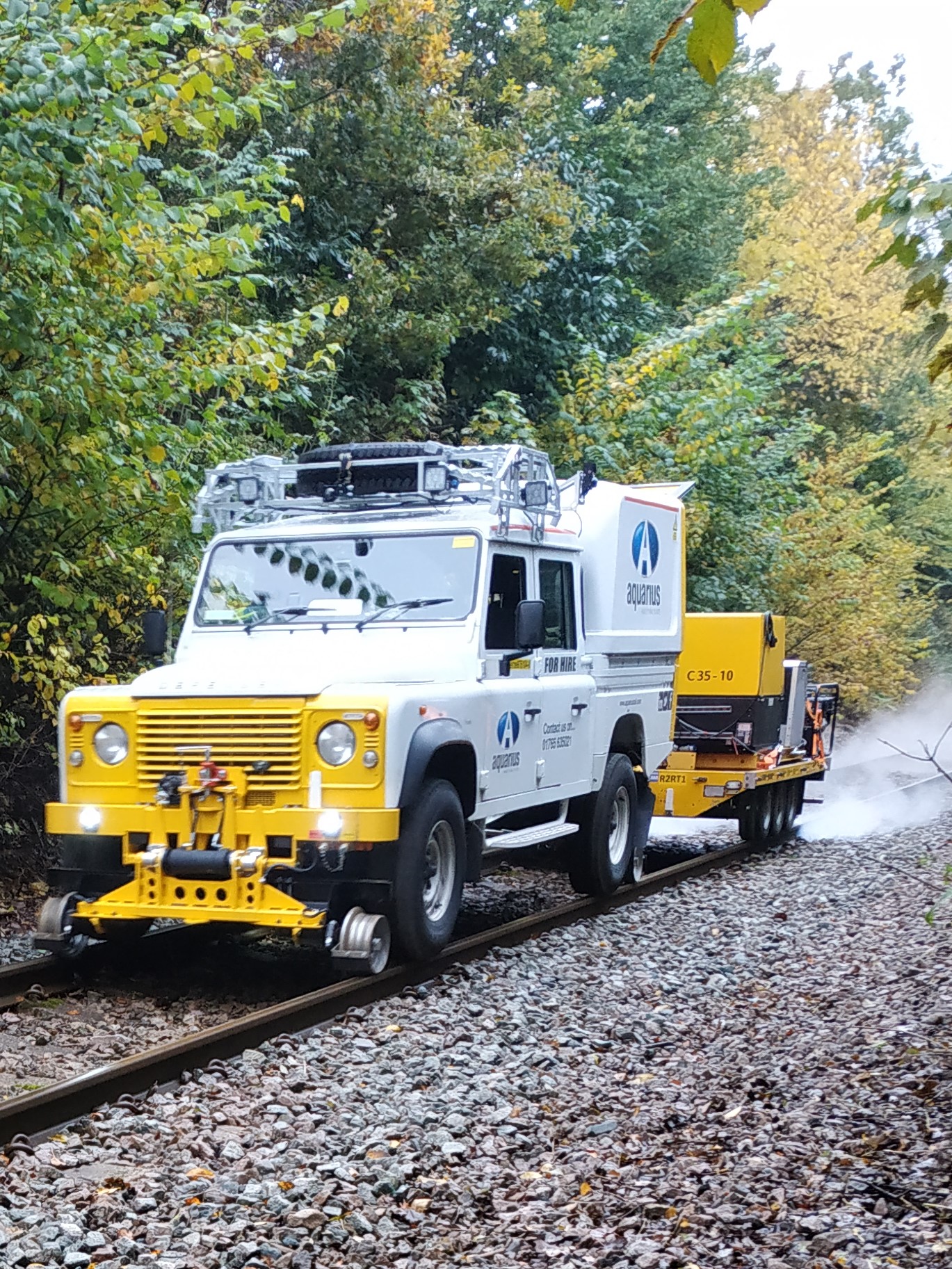
Plasma
Julian Swan, co-founder and engineering director of the Imagination Factory, discussed clearing leaves using a zero-contact electrical plasma jet. This produces an intense but focussed energy ‘beam’ using electricity and compressed gas and no other consumable materials.
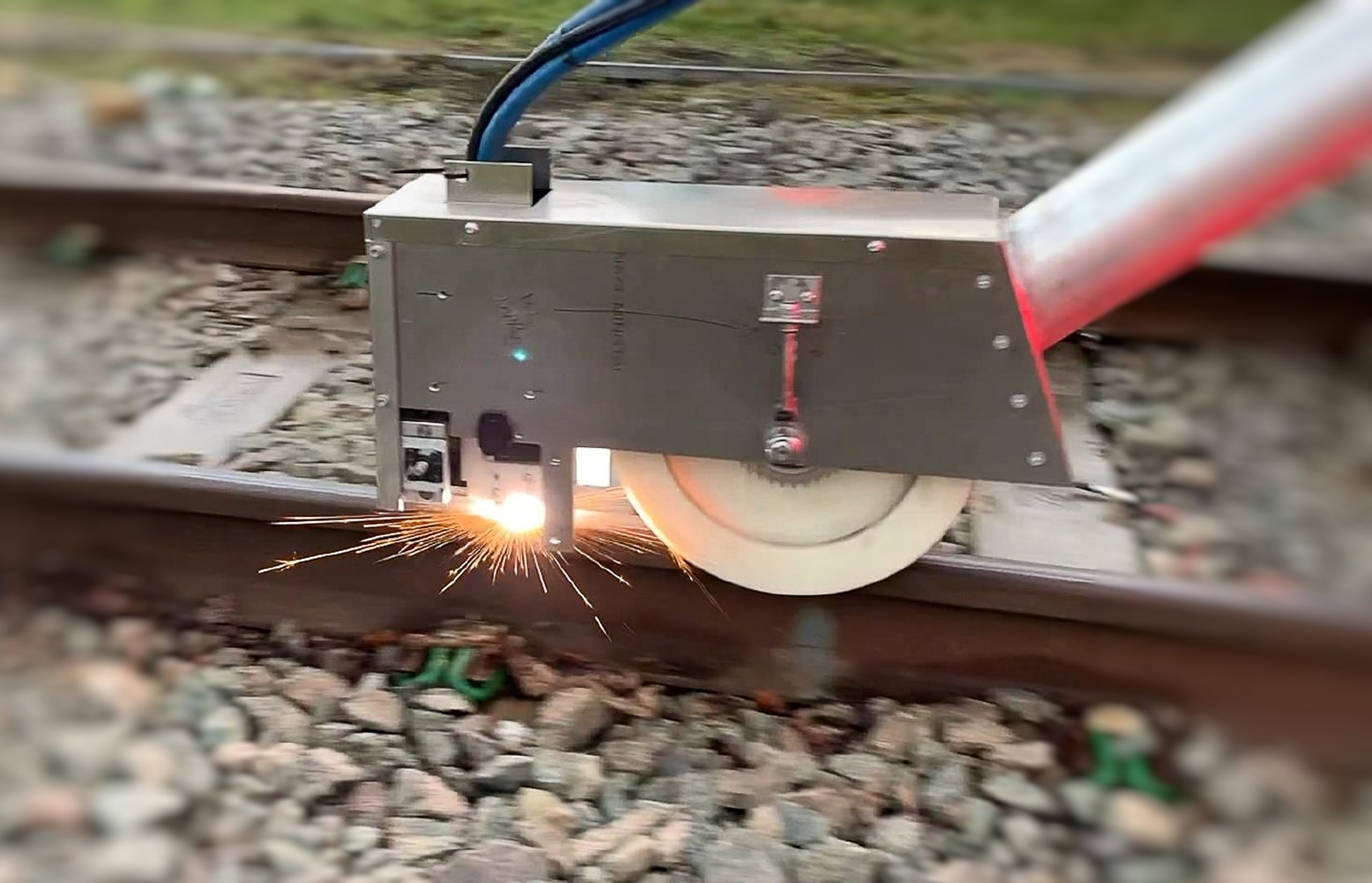
As plasma is often used for cutting metals up to 150mm thick, the challenge is therefore to clear the leaves without harming the track, requiring a good control system. Turning off the plasma at slow speeds or when stationary also helps!

After successful laboratory trials, a demonstrator was installed and tested on a container flat wagon. This delivered further confidence in the system and led to a prototype using a road-rail vehicle towing a custom road-rail trailer. The photographs comparing the rail contamination before and after being cleaned demonstrate the effectiveness of the system after one pass. Julian said the results are cumulative, with any residual contamination being removed on subsequent passes of the plasma jet.
As one might expect, the efficacy of the system depends both on the power of the plasma jet and the speed of the train. For a given speed, a 25kW plasma jet delivers “pretty clean” rail after one pass and “virtually clean” rail after two passes. In comparison, a 15kW jet takes four passes to deliver virtually clean rail.
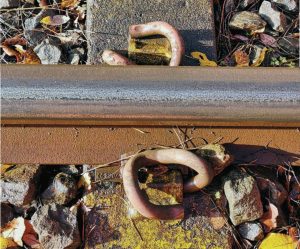
Julian illustrated how the system could be applied to a range of scenarios, being deployed from RRVs at <10 mph, high speed RHTTs, passenger and freight trains at >60 mph.
He paid tribute to his collaborators: British Steel, Metallisation, Microwave Technologies Consulting, Industrial Microwave Systems, The National Physical Laboratory and Knorr Bremse.
The Laser Train
Ben and Harm Medendorp of Laser Precision Solutions (LPS) presented their solution – cleaning the rails with lasers using the Pulsed Laser Ablation technique.
The use of laser technology was first put on rails two decades ago, having been trialled on Railtrack infrastructure under the name Laserthor in 1997. LPS started work in 2016 with the usual laboratory and prototype testing, but, since 2018, the company has been working with the Long Island Railroad (LIRR, part of the Metropolitan Transportation Authority of New York) to help it solve its leaf contamination problems.
In 2018, LPS demonstrated successful rail cleaning, delivering three times higher adhesion after one pass of the laser at 12mph, against a target of 9mph. This convinced LIRR to commission LPS to produce a fully operational prototype, capable of operation from a non-passenger train at 25mph. This was deployed for 12 hours a day in autumn 2019 over extensive parts of the LIRR network prone to low adhesion. A reliability of 99 per cent was achieved.
The results were impressive. Compared with 2018, LIRR reported a 17 per cent reduction in low adhesion events on the whole network and 65 per cent reduction on the lines where LaserTrain operated. There was a two per cent improvement in punctuality, 65 per cent fewer late trains due to “weather”, 32 per cent fewer short trains and 48 per cent fewer cancellations (the latter two points due to fewer units awaiting wheel flat repairs).
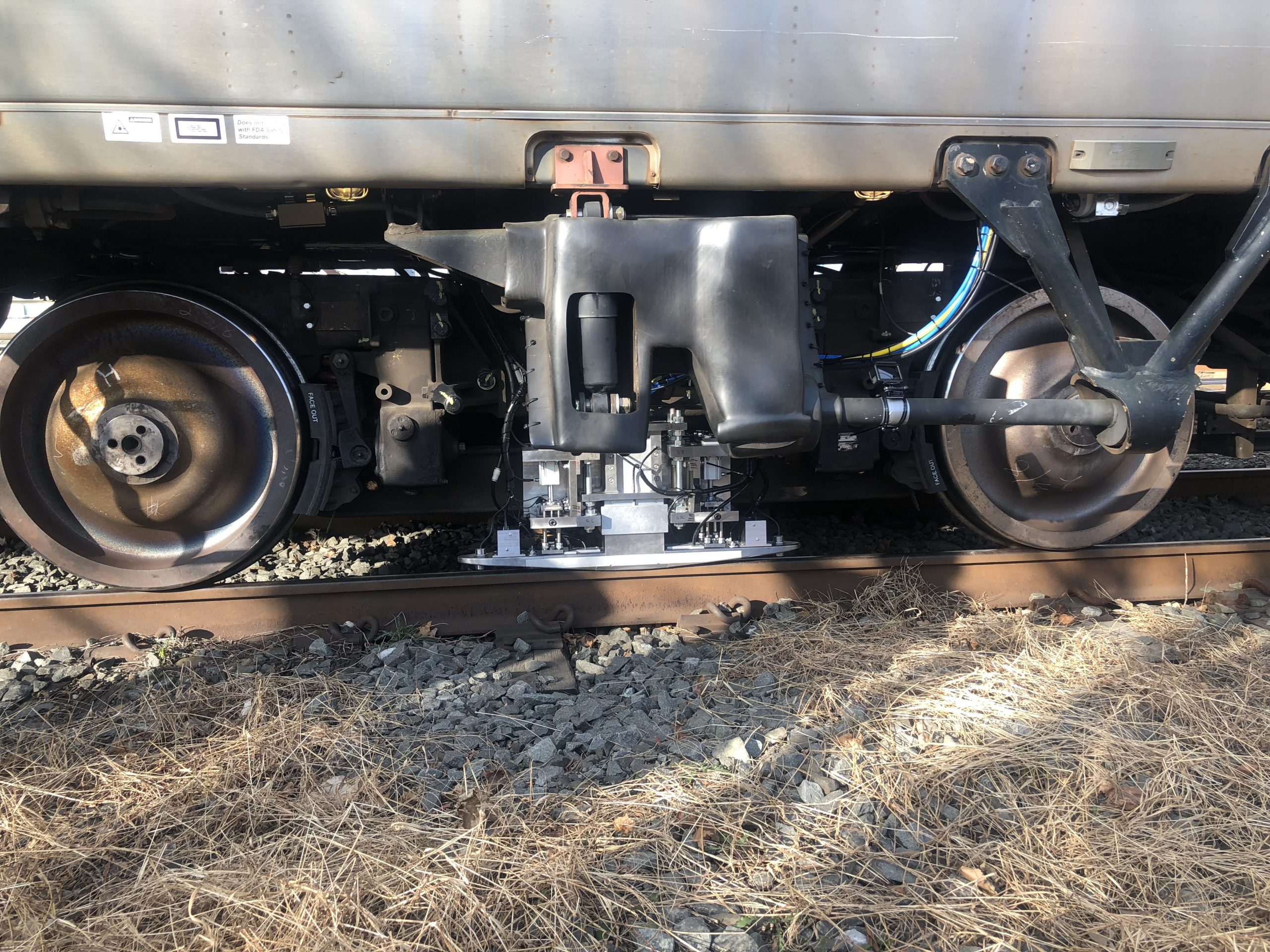
With fuel or any other source of energy as the only required input (35kW system consumption), the LaserTrain, logistically, is easy to implement.
The next stage is to scale the system so that it can operate at line speed (approximately 60 to 70mph). The required laser technology is ready and LPS is looking for a partner to put it to good use.
Water-Trak
At first sight, it seems odd to add water to slippery rails, but, of course, that is exactly what the RHTT does, leading to the questions “how much” and “when”?
John Cooke of CoCatalyst and Simon Barnard of SCB Associates explained: “The role of water in creating low adhesion is now well understood. We know that a dry track will deliver the highest level of adhesion. Wet track, while having a lower level of adhesion, will still give acceptable braking performance. When a critical amount of water (microlitres per metre) is present on the railhead together with contaminants (such as compressed leaf matter or iron oxides) the adhesion value can reduce radically (down to 0.01 to 0.02) resulting in very poor braking and traction. Water-Trak aims to move the railhead away from this highly undesirable condition by adding water.”
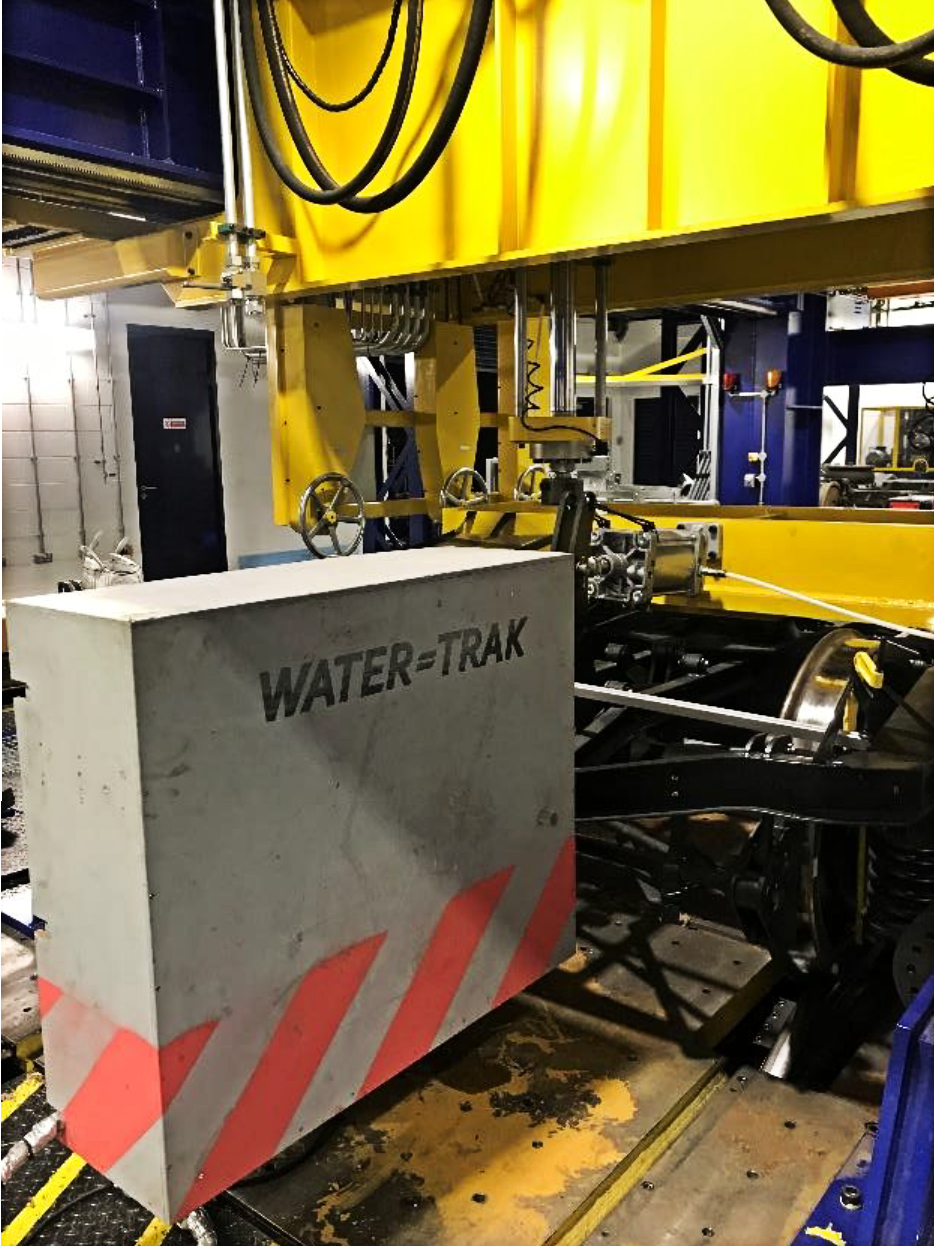
Introducing between 1ml/metre and 4ml/metre of water into the ‘nip’ between the wheel and the rail is enough to deliver this effect. Using Huddersfield’s HAROLD rig, a test of braking on a leaf layer led to significant wheel slide, with WSP (wheel slide protection) activity lasting for over 30 seconds. When water was introduced, the duration of WSP activity reduced by nearly two thirds. In addition, the tests results showed a significant improvement in wheel and track cleaning, indicating the potential of Water-Trak as a rail head treatment solution.
The speakers said that the current water system has a capacity of over 200 litres for both rails, giving a total dispense time of over 30 minutes. One system would be provided at each end of fixed formation trains. If water is delivered only on WSP activation, they estimated that the water would last for 1-2 weeks of operation, depending on the adhesion encountered by the train. If it was decided that there is a cleaning benefit to be derived from delivering water every time a train brakes, then the 200 litres of water would be sufficient for more than one day’s operation.
As to effectiveness in combination with sanding, a study by the University of Sheffield has shown that sanding performance is significantly improved when delivered onto a wet track; water helps to retain more sand on the rail. Water-Trak delivers water to the leading axle of the train so pre-wets the rail ahead of sand application. As the water does not interfere with, and may even enhance, the performance of track circuits, it also extends the operating envelope of low adhesion mitigation – it can work down to zero speed and in all locations, including points and crossings.
John told Rail Engineer that it is not yet clear if slip between the wheel and rail due to braking is key to the removal of contaminants. One possibility is that water softens the leaf layer, allowing the mechanical action of the wheel rolling on the rail, together with the high pressures generated, to accelerate its removal, remembering that parts of the contact patch will be experiencing creep due to wheel-rail deformation even when the wheel is just rolling on the rail. He added that CoCatalyst plans to run some further tests in which water is added without braking to explore this phenomenon.
John also acknowledged that they have more work to do to make the system suitable for freezing conditions!
In summary, this is a simple, low cost, low risk system that can improve traction and braking for following trains, so the benefits of fitting a lot of trains is cumulative.
Conclusion
The four techniques presented here have all demonstrated that they can effectively clean leaves off the rails. They are all at different levels of development – some have a degree of practical experience in improving adhesion on operating railways, whereas others have yet to emerge from the laboratory.
As always with these R&D projects, Rail Engineer will return to the topic as the projects progress.
Note: for more information on the plasma and laser processes, an examination of the Wikipedia articles on plasma cutting and laser ablation outlines some of the science.
Thanks to Paul Gray, Giulia Lorenzini and Ben Altman of RSSB, together with the presenters, for their help in preparing this article.


